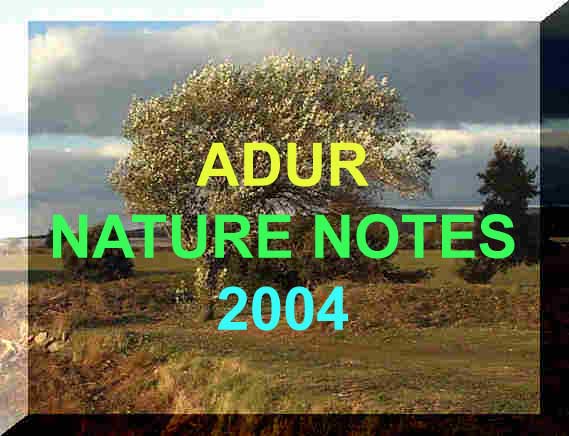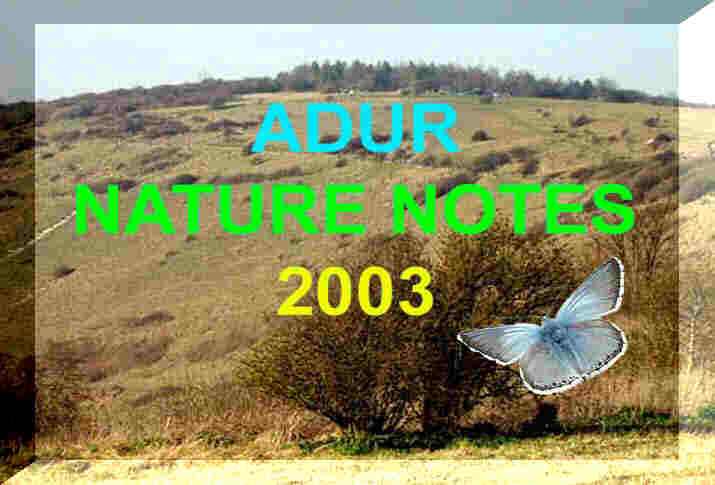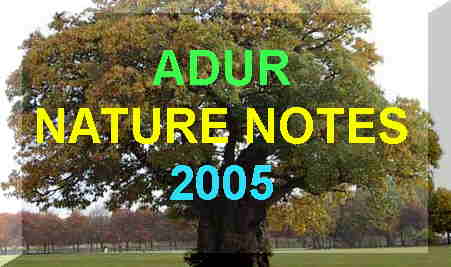Link
to the Hoverflies of 2006
25
October 2005
|
This small hoverfly was seen at the top of McIntyres Field, east of Lancing Clump. Platycheirus ? |
 |
 |
The only other hoverfly seen was a 50% larger Marmalade Fly Episyrphus balteatus.
9 October
2005
Frequent
Drone
Flies,
Eristalis,
Marmalade
Flies Episyrphus
balteatus, and at least one Syrphus
hoverfly
were
recorded on the Slonk Hill Cutting southern
path on passage.
| 3
October 2005
This very small species was recorded in Buckingham Park, Shoreham. The photograph is simply not good enough for ID. It could be a Melanostoma sp. (AH) |
 |
 |
2
October 2005
The frequent hoverflies in Shoreham town and gardens were Drone Flies, Eristalis tenax, Marmalade Flies Episyrphus balteatus, and there was at least one Myathropa florea seen and photographed. The small hoverfly on the left is thought to be a species of Platycheirusof which there were several in a Shoreham garden. The photograph shows the abdomen patterns enhanced to show as clearly as possible for identification purposes. |
27
September 2005
I
did not visit the Waterworks Road but
passage through the Butterfly Copse frequent hoverflies
(mostly Eristalis tenax
but also Syrphus).
| 25
September 2005
At least two pairs of Drone Flies, Eristalis tenax, were seen courting in in a Shoreham garden and they buzzed off when disturbed. |
 |
A handful of Drone Flies, Eristalis tenax, were seen in all shady places with vegetation and they were probably widespread and prevalent.
20
September 2005
A
Syrphus
hoverfly
was recorded in the Butterfly Copse (next to the Waterworks
Road).
18
September 2005
At
least one Drone Fly,
Eristalis
tenax, on
Slonk
Hill Cutting south, dozens of Marmalade
Flies Episyrphus
balteatus, and in a Shoreham garden
a Helophilus
pendulus buzzed around the pond
noisily.
13
September 2005
Hoverflies
were less than expected at the lower end of the Pixie
Path (route from the Waterworks Road
to Mill Hill) by the Butterfly Copse. A
handful of Drone Flies,
Eristalis,
flew
around the Ivy.
1 September
2005
Another
Volucella
zonaria was seen in the Butterfly
Copse next
to the Waterworks Road. There was a small
Syrphus
in
the same copse.
30
August 2005
The
hoverfly Helophilus
pendulus buzzed (I did not actually
hear it) around the brambles
in the south-west corner of the Mill Hill Cutting by the Pixie
Path.
25
August 2005
A
Volucella
zonaria hoverfly was photographed
on Buddleia in
my south Lancing garden, (TQ 186 044).
Passage by the Elm Corridor on New Monks Farm revealed two Volucella zonaria hoverflies and a further one at the Steyning Road entrance to the Maple Field Spinney by the Waterworks Road.
Volucella: Local List
 |
A
handful of this small species of hoverfly flitted around in Ray
Hamblett's south Lancing garden.
Syritta pipiens Identification by |
| 14
August 2005
This hoverfly from the top of The Drive, Shoreham looks like a Syrphus. This species is frequently seen. This ID is not confirmed. |
 |
| 9
August 2005
This hoverfly Volucella inanis was discovered in McIntyres Field, near Lancing Ring. The difference was noticed by Andy Horton from the more usual Volucella zonaria. This is the first confirmed record of this hoverfly on these Nature Notes pages. Photograph
by Ray
Hamblett
Subsequently,
a specimen of Volucella inanis
was identified from New Monks Farm seen
on
|
8 August
2005
Another
Volucella
zonaria next to the Waterworks
Road and this large hoverfly does not seem unusual any more, and along
with the ubiquitous and very common (500+ in a day) Marmalade
Fly Episyrphus
balteatus, frequent Scaeva
pyrastri, frequent Myathropa
florea and occasional Erastalis
tenax (the Drone Fly), means
that hoverflies are numerous and most of them I pass unrecognised.
2 August
2005
The
tall fragrant Fennel plant in my Lancing
front garden is now a magnet to the neighbourhood hoverflies. There are
around twenty hoverflies flitting around the flat umbelliforous flowers.
Most of them are the ubiquitous Marmalade
Fly Episyrphus
balteatus, others including Scaeva
are apparently taking the nectar from the flowers.
Another Volucella zonaria was seen in the scrub of the north-west of Mill Hill. Myathropa florea was widespread and frequent in the shadier places on the outskirts of Shoreham.
1 August
2005
In
the damp shade of the Elm Corridor on New Monks
Farm, flying insects included at least five species of hoverflies,
including two of the spectacular Volucella
zonaria, the black and yellow Chrysotoxum
bicinctum, the common Episyrphus
balteatus, and other familiar
species like Myathropa florea
and the small Sphaerophoria scripta.
A specimen of Volucella
inanis was confirmed by a photograph
(but not discovered until 17 August 2005).
This hoverfly is appreciably smaller than Volucella
zonaria.
 |
 |
 |
|
|
|
|
The hoverfly Volucella inanis visited my south Lancing garden.
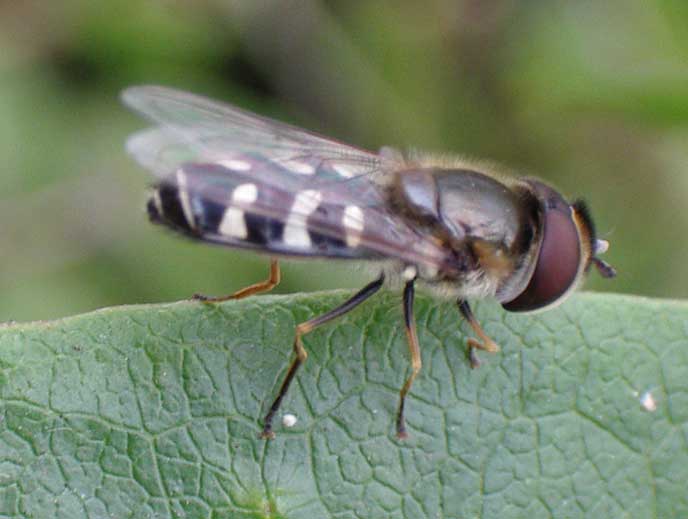 |
 |
 |
The first and third images are from the Slonk Hill south bank, and the middle image is from the upper slopes of Mill Hill, just north of the Reservoir. The first hoverfly is Scaeva pyrastri and the others and mating pair are Sphaerophoria scripta.
10
July 2005
Species
of hoverfly were collectively common in the
shadier bits of the Slonk Hill south spinney,
about 80 Episyrphus
balteatus and
at least a dozen Myathropa florea
and more than half a dozen of at least one other species.
 |
Chrysotoxum bicinctum |
9 July
2005
A
sighting of the large and spectacular hoverfly
Volucella zonaria over New
Monks Farm, Lancing, was the first of the year.
8 July
2005
Myathropa
florea
were frequent (20+) on the
shadier bits of the Slonk Hill south spinney
and present everywhere shady, but not as numerous as the common (100+)
Episyrphus
balteatus.
| 8
July 2005
Hoverfly on Ragwort This
looks to me more like a mimic of a bumblebee than
a bee because of the short antennae and hoverfly-like face.
Slonk Hill Cutting, south bank
|
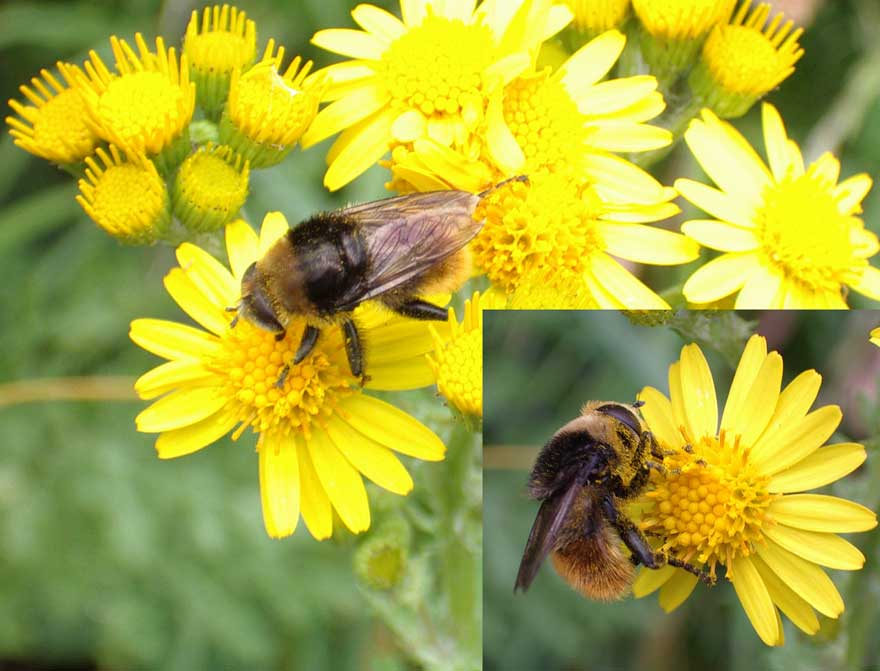 |
 |
7
July 2005
Volucella
pellucens
McIntyres Field east of Lancing Ring |
 |
7
July 2005
This hoverfly was photographed on Stinging Nettles in the in the Butterfly Copse next to the Waterworks Road and was completely forgotten at the time and the image only discovered on 31 October 2005. The hoverfly was not immediately identified. It looks like a Volucella pellucens. The variation in the colour, compared to the above specimen, could be a temperature difference in larval status. ID confirmed and comment by Bastiaan Wakkie on UK Hoverflies |
6 July
2005
Hoverflies
included the species Helophilus
pendulus (pic)
on and around the Stinging Nettles on the Waterworks
Road and the bumblebee
mimic Volucella
bombylans var. plumata
was instantly spotted at the western entrance to the Field Maple spinney.
2 July
2005
One
yellow and black hoverfly (it behaved like
a hoverfly) in the Butterfly Copse next to
the Waterworks Road was unfamiliar but
it flew away before it could be photographed. Another hoverfly was Volucella
inflata which I have only just been
able to recognise.
| 29
June 2005
Myathropa
florea
|
20
June 2005
A
distinctive hoverfly, the bumblebee mimic Volucella
bombylans var. plumata
was instantly spotted at the western entrance to the Field Maple spinney
(hereafter
called the Maple Spinney) footpath between
the Waterworks Road and the Steyning
Road. This hoverfly seems to be frequently seen (over 12 records, probably
more like 50) in June.
17
June 2005
Hoverflies
on the Slonk Hill southern bank included one
Volucella
bombylans var. plumata. This
species is a bumblebee mimic. My garden
in Corbyn Crescent hosted a Myathropa
florea.
 |
This
hoverfly was not recognised immediately. It is Volucella
inflata.
ID
by Jill
Mears on UK
Hoverflies
Report
and Photograph by Ray
Hamblett on Lancing Nature
Notes
|
12
June 2004
Two
of the usual hoverflies were on the A27
road bank at the top of The Drive in Shoreham:
Myathropa
florea distinguished by its appearance
and behaviour, and a familiar one that has escaped precise identification.
The hoverfly Merodon
equestris settled in a Shoreham garden.
| 9
June 2004
This hoverfly Helophilus pendulus buzzes like a blow-fly and could be mistaken for a wasp so I doubt it is high on the general popularity stakes. However, it hovers like it should and returns to the same leaf repeatedly, so it is quite obliging for the photographer under the strong sun, as it hovered around my garden pond in Corbyn Crescent, Shoreham. |
 |
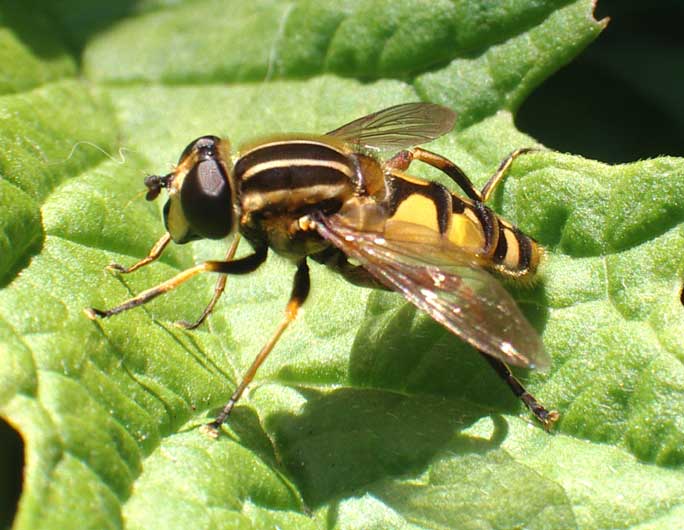 |
7 June
2005
At
the top of The Drive, Shoreham, Marmalade
Flies, Episyrphus
balteatus, and other hoverflies were
noticed in numbers in excess of twenty on one bush.
27
May 2005
A
handful of the pretty hoverfly Leucozona
lucorum were seen in the shady area
at the top of The Drive, Shoreham.
 |
23
May 2005
This is another small garden species of hoverfly that visited the only Bulbous Buttercup in my front garden in a crowded industrial area of Shoreham. I think this is the prevalent Sphaerophoria species (S. scripta) but I have not double-checked for close species (which is an unlikely differentiation from a photograph). |
| 22
May 2005
A small
species that is frequent in a Shoreham garden.
It would not settle and the poor quality photograph was taken of the hoverfly
in flight. This one looks like Epistrophe
eligans.
ID
by Leon Truscott on UK
Hoverflies
|
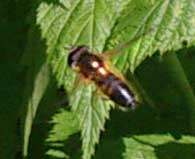 |
18
May 2005
At
the Mash Barn Lane end of New Monks Farm,
Lancing, the hoverfly
Volucella
bombylans var. plumata was
seen.
 |
7
May 2005
This hoverfly was recorded from Mash Barn Lane, Lancing, leading to New Monks Farm Eupeodessp. - probably E. corollae ID
by Leon Truscott on UK
Hoverflies
Identification
by Steven Falk (Senior
Keeper of Natural History, Warwickshire Museum)
|
| 7
May 2005
The
Hoverfly, Epistrophe
eligans, was
recorded from New Monks Farm (Lancing)
but not identified correctly until much later.
ID
by Bastiaan Wakkie on UK
Hoverflies
|
 |
 |
6
May 2005
The
common Alexanders
on the southern part of Mill
Hill attracted hoverflies. The photograph
is the hoverfly Leucozona
lucorum. There has been an explosion
of this species in Holland and Belgium this year. This pretty little hoverfly
is widespread and common in England.
|
29
April 2005
The
two following species are thought most likely to be hoverflies.
 |
 |
 |
The
first one was discovered on Green Alkanet
at
the southern end of the Waterworks Road.
The upturned snout indicates a species of Rhingia
although
this protuberance (elongated face) would seem more suitable for feeding
on the prevalent White Dead-nettle
rather than the plant it was on.
Rhingia
campestris for comparison (Link)
Comparison
photo of R. campestris and R. rostrata (Link to photographs
by Nigel Jones)
The
lateral margins of the tergites (dorsal segments) are edged black in R.
campestris, this is clearly visible on the image posted. R. rostrata
lacks this feature. Source.
The second smaller brown fly (above right photograph) was ubiquitous on wasteland like the Dovecote Bank.
27
April 2005
The
very small Melanostoma scalare hoverflies
were seen in the scrubby sheltered areas of north-west Mill
Hill.
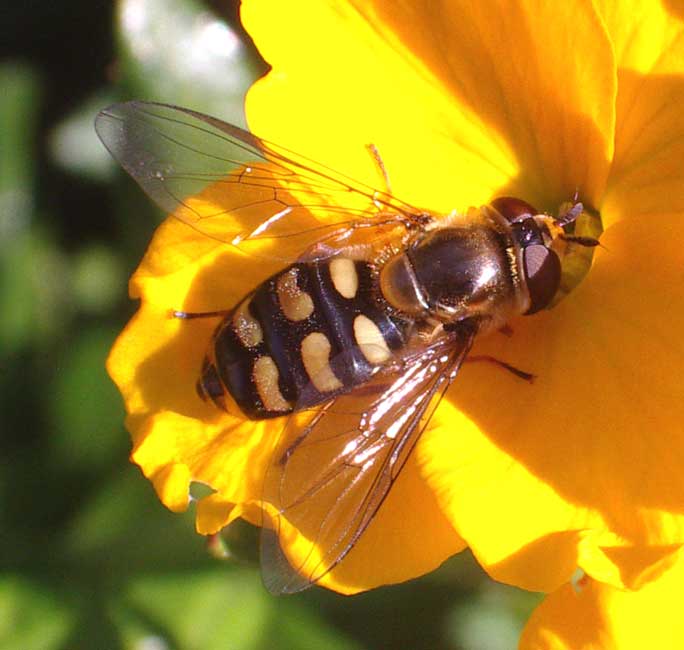 |
17
April 2005
There were more species of hoverflies noticed including a species of Eupeodes (=Metasyrphus) in a Shoreham garden. This species is Eupeodes luniger (=Metasyrphus) The
outer points of the lunules stop well short of the margin (they reach the
margin in Eupeodes corollae).
ID
by David Iliff on UK
Hoverflies Yahoo Group
|
 |
15-16
April 2005
Hoverflies were out on the wasteland on the edge of Shoreham town, especially on the Dovecote Bank: Eristalis pertinax, Erastalis tenax and a species of Syrphus were recognised, but there could have been other species. The very small hoverfly on
the left is from the Pixie Path.
Identification
by David Iliff on UK
Hoverflies
|
3 April
2005
The
hoverflies
and
bees
are out in the sunshine for the first time this year. There was a handful
of
Episyrphus balteatus and
the first two photographed below:
 |
 |
 |
| This hoverfly looked like a bee mimic as well, but it was spotted hovering before it found this inelegant resting place in a Shoreham garden | This insect photographed
on a Dandelion at the top
of The Drive, Shoreham looks familar, but it does not seem to have
been photographed before.
Note the slender "waist" though. It was not seen hovering. This is a Mining Bee, Andrena fucata Earlier Mining Bee (Link) |
Probably Eristalis sp. taken on 29 September 2004 for comparison purposes |
|
ID confirmed by Leon Truscott |
Notes |
Certainly
not a hoverfly, it has two pairs of wings. I printed off a copy and used
a magnifying glass, looked at the wing venation [using
Willmer] 3 SM cells; BV straight; D1 rhomboid;
SM2 < SM3; hairy, brownish; the rest difficult to see but heading for
Andrena
sp. However, look at the abdominal
segment nearest the "waist" - I don't have a completely sharp pic - but
I think I can
see
something protruding from between the segments at the left hand side?
What do you think? Considering that the lethargic bee I found on a dandelion
flower [mine
was identified by Stuart
Roberts as Andrena chrysosceles]
was parasitised by 3 x female Stylops, it looks v. similar to your bee.
Andrena
shortlist

26
March 2005
The
small hoverfly Meliscaeva auricollis
was seen at St. James the Less churchyard, Lancing.
Photograph
(Link)
4 November 2004
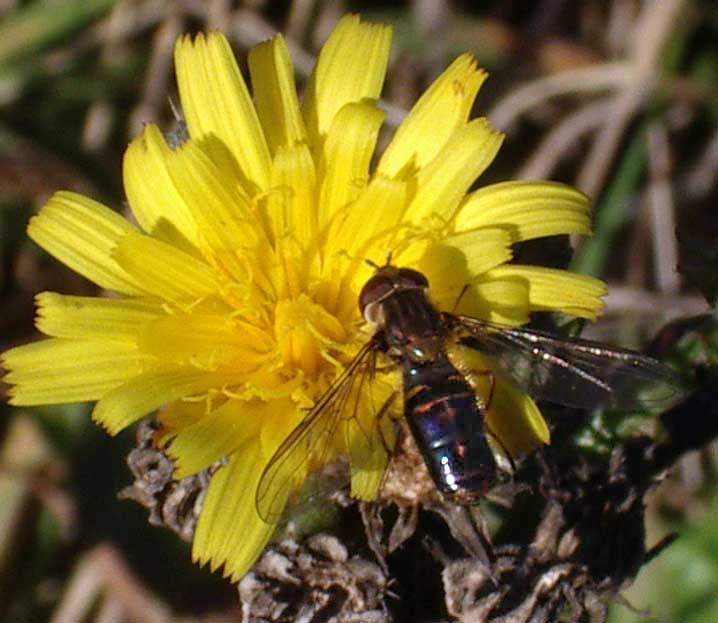 On
the footpath approach to Mill Hill
from the Waterworks Road I was buzzed by
a few hoverflies
of two species. One of these nectar seeking insects was the Drone
Fly (hoverfly) and the other smaller one
was still awaiting positive identification at the time of writing.
It hovered and behaved like a hoverfly. It
is the photograph above left.
On
the footpath approach to Mill Hill
from the Waterworks Road I was buzzed by
a few hoverflies
of two species. One of these nectar seeking insects was the Drone
Fly (hoverfly) and the other smaller one
was still awaiting positive identification at the time of writing.
It hovered and behaved like a hoverfly. It
is the photograph above left.
This is a black colour form of the abundant Episyrphus balteatus.
Because the insect was so dark in the photograph above I accentuated the markings in Photoshop (image manipulation program). The first photograph is shown on the right of how it appeared in real life.
4
October 2004
On
the footpath approach to Mill Hill
from the Waterworks Road, at least three
species of hoverflies including one Helophilus
pendulus, a handful of Syrphus
hoverflies
(with
a yellow face and a bright yellow abdomen when viewed from the side)
shown in the photograph below, as well as Drone
Flies,
Eristalis,
were attracted to the Ivy.
 |
 |
 |
21
September 2004
There
were two distinctive hoverflies on the ivy with bees,
wasps
and Drone Flies
next (west side) to the footpath approach to Mill
Hill from the Waterworks Road: the medium
sized Helophilus pendulus which
I had not recorded before, and the large colourful Volucella
zonaria.
16
September 2004
The
following hoverflies were photographed on the footpath approach to Mill
Hill from the Waterworks Road:
 |
 |
 |
The
first two are the same species, probably Eristalis,
and could be mistaken for bees. The one on the extreme right looks like
Syrphus.
Hoverflies
(Syrphidae), tribe Eristalini
9 September
2004
 |
 |
|
| Erastalis
tenax (the Drone Fly) is the female of this species of hoverfly
seen
in Ray
Hamblett's south Lancing garden (TQ
186 044)
ID confirmed by Steven Falk (Warwickshire Museum RINGS) on UK Hoverflies. ID message by Steven Falk. |
Butterfly Copse (TQ 209 063) near Waterworks Road Epistrophe (poetical) |
Eristalis
pertinax (not this one)
General
Notes (not referring to this specimen):
E.
pertinax is a common and fairly easily recognised species, though it
can be confused with the Drone Fly, E. tenax. The latter has a broader
facial stripe between the eyes and little or no yellow on the legs - specifically
the tibiae of the hind legs are dark in E. tenax whereas they are
distinctly bicoloured in E. pertinax. Whereas the abdomen is tapering
in E. pertinax, causing it to resemble a worker Honey Bee, the abdomen
is more nearly cylindrical and "chunkier" in E. tenax, so it is
more like the drone.
Source:
Dr.
Alan J. Silverside
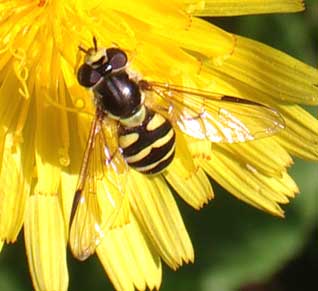 |
3
September 2004
This small hoverfly was photographed along the South Downs Coastal Link cyclepath. |
31
August 2004
The
large hoverfly Volucella
zonaria was nectaring on Ivy near
the Butterfly Copse next to the Waterworks Road.
 |
 |
 |
30
July 2004
The
Hoverfly,
Episyrphus
balteatus, is now common with over
a hundred in a single Shoreham garden and these
numbers are expected to be repeated everywhere locally.
25
July 2004
 |
 |
 |
|
25 July 2004 ID by David Iliff on UK Hoverflies Shoreham garden |
18 August 2004 Recorded on the footpath from The Street to the Waterworks Road at the top (The Street) end. |
A27 Road Bank The hoverfly landed on a leaf very quickly and then flew off. It is Erastalis tenax (the Drone Fly) remarkably mimicking? a Honey Bee. |
18
July 2004
As
the sun struggled to come out, so did the flying insects including at least
five species of hoverflies. Five of them were seen in a small patch of
garden
(amounting to a half a dozen flowers and shrubs) near Buckingham Park,
Shoreham.
 |
 |
|
|
|
despite the wider abdomen |

The colourful species of hoverfly known as Helophilus pendulus appeared in my south Lancing garden (TQ 186 044), around the pond, on a thundery day. Also, another pair of hoverflies seem to match other recent sightings of Eupeodes corollae. But according to experts it may be a little hasty to assume the identification to species level is correct. The genus Eupeodes is correct. |















